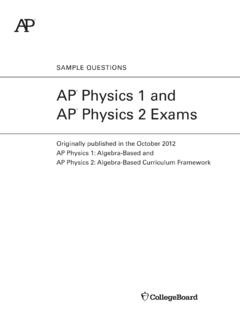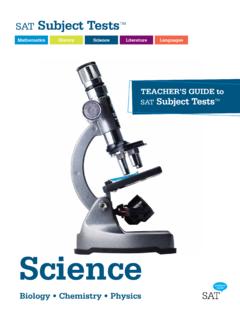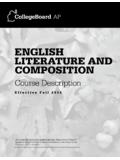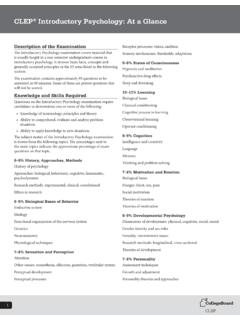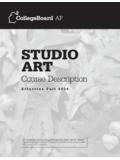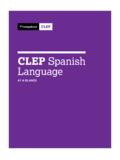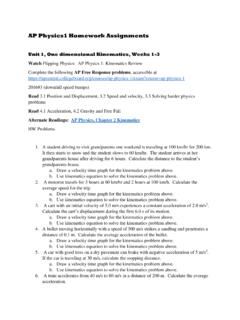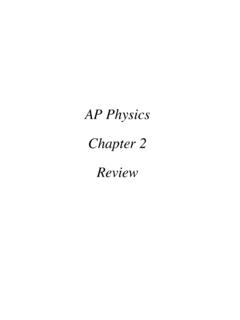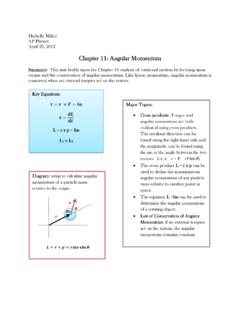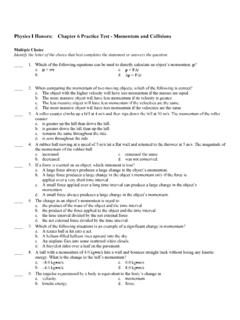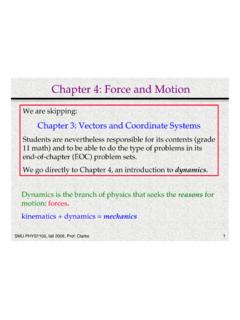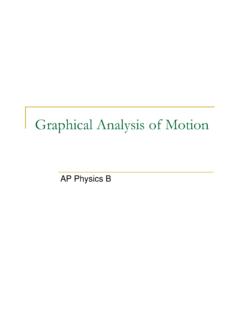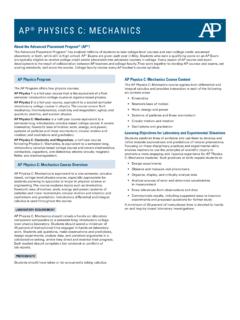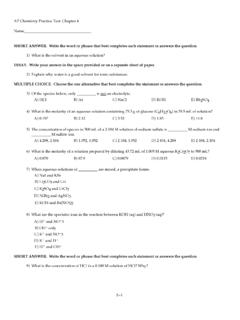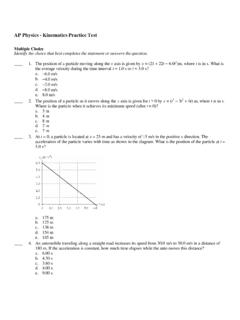Transcription of Adding Inquiry to AP® Physics 1 and 2 Investigations
1 X Adding Inquiry to AP Physics 1 and 2 Investigations : A Teacher's Guide with Four Sample LabsA Teacher's Guide with Four Sample LabsThe College Board New York, NY About the College Board The College Board is a mission-driven not-for-profit organization that connects students to college success and opportunity. Founded in 1900, the College Board was created to expand access to higher education. Today, the membership association is made up of over 6,000 of the world s leading educational institutions and is dedicated to promoting excellence and equity in education. Each year, the College Board helps more than seven million students prepare for a successful transition to college through programs and services in college readiness and college success including the SAT and the Advanced Placement Program.
2 The organization alsoserves the education community through research and advocacy on behalf of students, educators and schools. For further information, visit AP Equity and Access PolicyThe College Board strongly encourages educators to make equitable access a guiding principle for their AP programs by giving all willing and academically prepared students the opportunity to participate in AP. We encourage the elimination of barriers that restrict access to AP for students from ethnic, racial and socioeconomic groups that have been traditionally underserved. Schools should make every effort to ensure their AP classes reflect the diversity of their student population.
3 The College Board also believes that all students should have access to academically challenging course work before they enroll in AP classes, which can prepare them for AP success. It is only through a commitment to equitable preparation and access that true equity and excellence can be achieved. 2014 The College Board. College Board, Advanced Placement, Advanced Placement Program, AP, AP Central, and the acorn logo are registered trademarks of the College Board. All other products and services may be trademarks of their respective owners. Visit the College Board on the Web: Contents Introduction .. 1 chapter 1: About This Guide .. 3 chapter 2: Creating an Inquiry -Based Learning Environment.
4 6 chapter 3: The Role of the Science Practices .. 10 chapter 4: Experimental Data Analysis .. 14 chapter 5: Written, Verbal, and Visual Communication .. 27 chapter 6: Making AP Physics 1 and 2 Inclusive for All Learners .. 29 References .. 32 AP Physics 1 Sample # 1: Newton s Second Law .. 33 AP Physics 1 Sample Lab # 2: Conservation of Energy .. 48 AP Physics 2 Sample Lab # 1: Magnetism .. 64 AP Physics 2 Sample Lab # 2: Geometric Optics .. 81 Appendix: Rubrics for Science Practices in AP Physics 1 and 2 Investigations .. 93 Adding Inquiry to AP Physics 1 and 2 Investigations Introduction 1 Introduction AP Physics 1 and AP Physics 2 are designed as yearlong college-level courses with each course requiring a minimum of 25% of instructional time to be spent engaged in laboratory work.
5 Additionally, students must be provided with an opportunity to engage in a minimum of 14 labs that collectively address the foundational Physics principles in each course, with at least half of the labs conducted in a guided or open Inquiry format. Inquiry -based laboratory Investigations are integral to the AP Physics 1 and 2 courses because they provide opportunities for students to apply the seven science practices (defined in the curriculum framework) as they identify the questions they want to answer, design experiments to test hypotheses, conduct Investigations , collect and analyze data, and communicate their results. As a result, students are able to concentrate on understanding concepts and developing the reasoning skills essential to the study of Physics .
6 This guide will help you devise Inquiry -based instructional approaches for AP Physics 1 and 2 labs in the 2014-15 school year. It also includes the four previously released sample labs (two for AP Physics 1 and two for AP Physics 2) that you can use as models as you prepare your syllabus. Teachers are encouraged to develop their own Inquiry -based labs that address the learning objectives in the Curriculum Framework. You should also consider supporting your physical laboratory work with interactive, online simulations, such as PhET simulations developed by the University of Colorado, Boulder. To assist and support teachers in this process, the College Board operates the online AP Teacher Community ( ), which provides opportunities for collaboration and the sharing of resources and ideas.
7 To come: A complete teacher s manual The College Board is currently developing the AP Physics 1 and 2 Inquiry -Based Lab Investigations : A Teacher s Manual to be published in February 2015. This manual will include everything in this Guide to Inquiry plus an additional 12 Inquiry -based labs (see list below), for a total of 16 labs. These labs will be examples of the kind of Investigations that students should engage in, but are not to be considered required Investigations ; and while they will cover the foundational Physics principles for each of the two courses, they are not intended to be the only Investigations that students should be engaged in during the course of study in AP Physics .
8 The Investigations will illustrate a variety of approaches and the different levels of guidance and support that you can use when implementing Inquiry -based laboratory work. None of the labs provided will require a significant investment in new equipment. However, since an AP lab should provide an experience equivalent to that of a college laboratory, you should make every effort to provide a range of experiences from experiments students contrive from plumbing pipe, string and duct tape, to Investigations in which students gather and analyze data using calculator or computer-interfaced equipment. Adding Inquiry to AP Physics 1 and 2 Investigations Introduction 2 Inquiry -based Investigations to be included in the upcoming Teacher s Manual AP Physics 1 Lab Investigations AP Physics 2 Investigations 1D and 2D Kinematics Boyle s Law *Newton s Second Law Fluid Dynamics Circular Motion RC Circuits *Conservation of Energy *Magnetism Impulse and Momentum Electromagnetic Induction Harmonic Motion *Geometric Optics Rotational Motion The Particle Model of Light Mechanical Waves Resistor Circuits _____ *This lab is also one of the four sample labs.
9 Adding Inquiry to AP Physics 1 and 2 Investigations chapter 1 3 chapter 1: About This Guide The AP Physics 1 and Physics 2 algebra-based courses are designed to promote student learning of essential Physics content and foster development of deep conceptual understanding through an Inquiry -based model of instruction. The instructional approaches utilized in this guide are informed by several decades of research on student learning and knowledge construction, especially with regard to Physics principles. (Further discussion of Inquiry -based instructional approaches is found in chapter 2.) In this Inquiry -based model, students learn by engaging in the seven AP Science Practices that develop their experimental and reasoning skills.
10 By engaging in the science practices students begin to see that the study of Physics is much more than just gaining knowledge about our physical world, but also requires practices that are used to establish, extend, and refine that knowledge over time (NRC, 2012). The science practices (summarized in chapter 3 and more fully described in the curriculum framework) enable students to make predictions of natural phenomena, develop and refine testable explanations, and use established lines of evidence and reasoning to support claims. To create a model of excellence for the lab component in AP science courses, the College Board, in conjunction with the Lab Vision Team and Physics Lab Development Team, worked to create an innovative vision and approach to lab Investigations .
